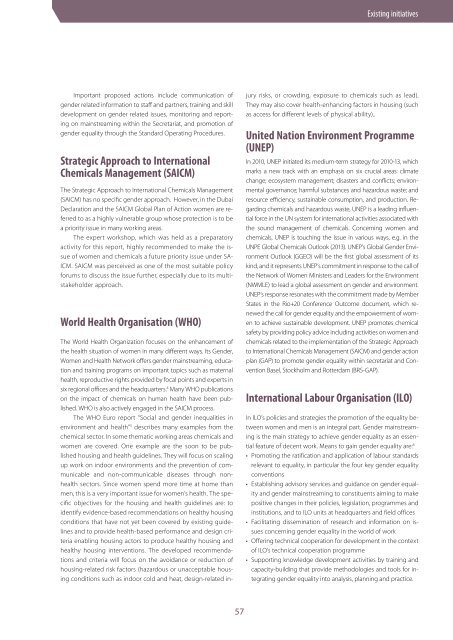Women and Chemicals
1ToENNR
1ToENNR
Create successful ePaper yourself
Turn your PDF publications into a flip-book with our unique Google optimized e-Paper software.
Existing initiatives<br />
Important proposed actions include communication of<br />
gender related information to staff <strong>and</strong> partners, training <strong>and</strong> skill<br />
development on gender related issues, monitoring <strong>and</strong> reporting<br />
on mainstreaming within the Secretariat, <strong>and</strong> promotion of<br />
gender equality through the St<strong>and</strong>ard Operating Procedures.<br />
Strategic Approach to International<br />
<strong>Chemicals</strong> Management (SAICM)<br />
The Strategic Approach to International <strong>Chemicals</strong> Management<br />
(SAICM) has no specific gender approach. However, in the Dubai<br />
Declaration <strong>and</strong> the SAICM Global Plan of Action women are referred<br />
to as a highly vulnerable group whose protection is to be<br />
a priority issue in many working areas.<br />
The expert workshop, which was held as a preparatory<br />
activity for this report, highly recommended to make the issue<br />
of women <strong>and</strong> chemicals a future priority issue under SA-<br />
ICM. SAICM was perceived as one of the most suitable policy<br />
forums to discuss the issue further, especially due to its multistakeholder<br />
approach.<br />
World Health Organisation (WHO)<br />
The World Health Organization focuses on the enhancement of<br />
the health situation of women in many different ways. Its Gender,<br />
<strong>Women</strong> <strong>and</strong> Health Network offers gender mainstreaming, education<br />
<strong>and</strong> training programs on important topics such as maternal<br />
health, reproductive rights provided by focal points <strong>and</strong> experts in<br />
six regional offices <strong>and</strong> the headquarters. 4 Many WHO publications<br />
on the impact of chemicals on human health have been published.<br />
WHO is also actively engaged in the SAICM process.<br />
The WHO Euro report “Social <strong>and</strong> gender inequalities in<br />
environment <strong>and</strong> health” 5 describes many examples from the<br />
chemical sector. In some thematic working areas chemicals <strong>and</strong><br />
women are covered. One example are the soon to be published<br />
housing <strong>and</strong> health guidelines. They will focus on scaling<br />
up work on indoor environments <strong>and</strong> the prevention of communicable<br />
<strong>and</strong> non-communicable diseases through nonhealth<br />
sectors. Since women spend more time at home than<br />
men, this is a very important issue for women’s health. The specific<br />
objectives for the housing <strong>and</strong> health guidelines are: to<br />
identify evidence-based recommendations on healthy housing<br />
conditions that have not yet been covered by existing guidelines<br />
<strong>and</strong> to provide health-based performance <strong>and</strong> design criteria<br />
enabling housing actors to produce healthy housing <strong>and</strong><br />
healthy housing interventions. The developed recommendations<br />
<strong>and</strong> criteria will focus on the avoidance or reduction of<br />
housing-related risk factors (hazardous or unacceptable housing<br />
conditions such as indoor cold <strong>and</strong> heat, design-related injury<br />
risks, or crowding, exposure to chemicals such as lead).<br />
They may also cover health-enhancing factors in housing (such<br />
as access for different levels of physical ability)..<br />
United Nation Environment Programme<br />
(UNEP)<br />
In 2010, UNEP initiated its medium-term strategy for 2010-13, which<br />
marks a new track with an emphasis on six crucial areas: climate<br />
change; ecosystem management; disasters <strong>and</strong> conflicts; environmental<br />
governance; harmful substances <strong>and</strong> hazardous waste; <strong>and</strong><br />
resource efficiency, sustainable consumption, <strong>and</strong> production. Regarding<br />
chemicals <strong>and</strong> hazardous waste, UNEP is a leading influential<br />
force in the UN system for international activities associated with<br />
the sound management of chemicals. Concerning women <strong>and</strong><br />
chemicals, UNEP is touching the issue in various ways, e.g. in the<br />
UNPE Global <strong>Chemicals</strong> Outlook (2013). UNEP’s Global Gender Environment<br />
Outlook (GGEO) will be the first global assessment of its<br />
kind, <strong>and</strong> it represents UNEP’s commitment in response to the call of<br />
the Network of <strong>Women</strong> Ministers <strong>and</strong> Leaders for the Environment<br />
(NWMLE) to lead a global assessment on gender <strong>and</strong> environment.<br />
UNEP’s response resonates with the commitment made by Member<br />
States in the Rio+20 Conference Outcome document, which renewed<br />
the call for gender equality <strong>and</strong> the empowerment of women<br />
to achieve sustainable development. UNEP promotes chemical<br />
safety by providing policy advice including activities on women <strong>and</strong><br />
chemicals related to the implementation of the Strategic Approach<br />
to International <strong>Chemicals</strong> Management (SAICM) <strong>and</strong> gender action<br />
plan (GAP) to promote gender equality within secretariat <strong>and</strong> Convention<br />
Basel, Stockholm <strong>and</strong> Rotterdam (BRS-GAP).<br />
International Labour Organisation (ILO)<br />
In ILO’s policies <strong>and</strong> strategies the promotion of the equality between<br />
women <strong>and</strong> men is an integral part. Gender mainstreaming<br />
is the main strategy to achieve gender equality as an essential<br />
feature of decent work. Means to gain gender equality are: 6<br />
• Promoting the ratification <strong>and</strong> application of labour st<strong>and</strong>ards<br />
relevant to equality, in particular the four key gender equality<br />
conventions<br />
• Establishing advisory services <strong>and</strong> guidance on gender equality<br />
<strong>and</strong> gender mainstreaming to constituents aiming to make<br />
positive changes in their policies, legislation, programmes <strong>and</strong><br />
institutions, <strong>and</strong> to ILO units at headquarters <strong>and</strong> field offices<br />
• Facilitating dissemination of research <strong>and</strong> information on issues<br />
concerning gender equality in the world of work<br />
• Offering technical cooperation for development in the context<br />
of ILO’s technical cooperation programme<br />
• Supporting knowledge development activities by training <strong>and</strong><br />
capacity-building that provide methodologies <strong>and</strong> tools for integrating<br />
gender equality into analysis, planning <strong>and</strong> practice.<br />
57


